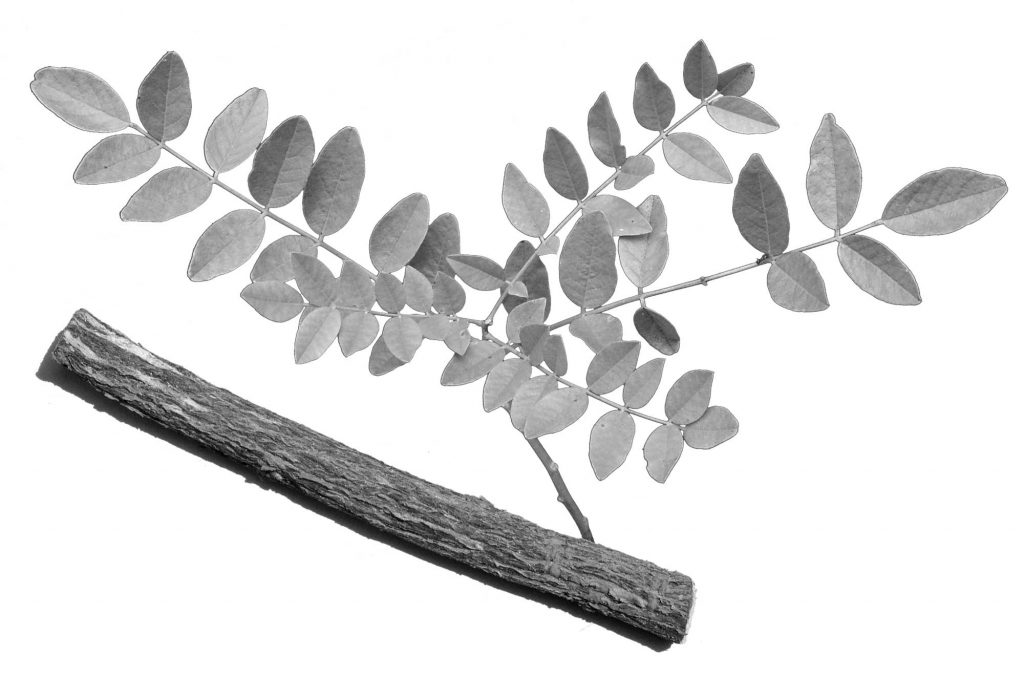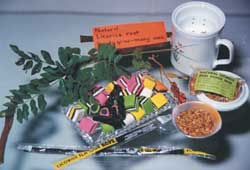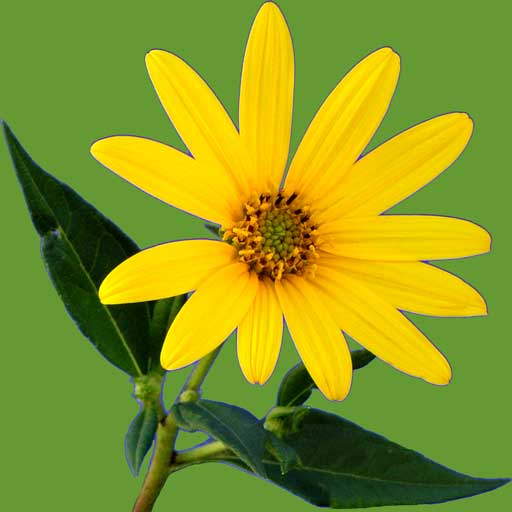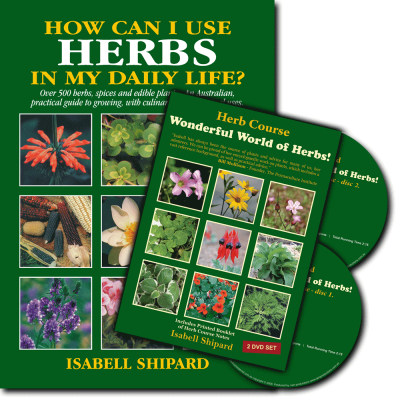Liquorice, Sweet Root, Liquirizia, Reglissa, Sweet Wood, Black
Sugar, Gan-cao
Glycyrrhiza glabra F. Fabaceae
Description
It is believed the plant originates from the East, however, it has been grown since early times in China, Africa, Europe, India and the Middle East.

A very hardy, deciduous perennial to 1 metre or taller, growing from a strong root system made up of a taproot and many horizontal-spreading roots, spanning out 1 metre or more. Roots are 1-5cm thick, have a brown woody appearance, a yellow colour internally with fibre that can be pulled apart like long string. Above ground foliage forms on upright thin stems, pinnate leaves with 4-8 pairs of dark green elliptic leaflets 2-3cm long of fern-like appearance. Young leaves feel slightly sticky to touch. Lavender/blue pea flowers 1cm long form as axil clusters, followed by 2-3cm long smooth, brown pods containing 1-7 brown kidneyshaped, pinhead-sized seeds.
Plant licorice in well-limed, well-drained, loose, deep soil; preferably in a sunny position. If soil tends to be clayey, plant on raised beds or hills. Enriching the soil with compost and well-rotted animal manure is beneficial. Licorice should be given room to spread, at least 1-3 square metres. It is a good sign when the plant starts to sucker and send up new shoots, as it signifies roots are growing, with potential for future harvesting. It is the root that gives the flavouring, sweetness and therapeutic uses. Low growing annual herbs or vegetables can be grown around it for 1-2 years.
… … omitted text, please see How can I use HERBS in my daily life? for full text.

Licorice will do well in temperate, warm and sub-tropical climates; also in tropical areas provided the soil is free draining during wet humid weather. Licorice is not bothered by frosts, as it is dormant in winter, and actually benefits by the defined cold period, which induces the translocation of properties to the underground rhizomes. If plants are mulched thickly, to deter weeds and retain moisture, they will require little attention; but do take time to talk to them and encourage them to produce lots of yummy roots. Roots are dug, washed, and dried in the sun, shade or artificially. Fresh roots are pliable and cut easily. Once dried, roots must be stored away from heat, light and moisture (moisture from the atmosphere can cause mould to grow on roots), and the roots will keep their properties and flavour indefinitely. Licorice can be called a survival food, not only because it stores well, but for its use as a sugar replacement, a refreshing beverage, and its potential to quench the thirst, allay hunger, and its benefits for endurance. There are over 15 species of glycyrrhiza, but not all have sufficient sweetness to be of commercial use, or recognised for medicinal use.
Constituents:
volatile oils, fixed oils, linoleic and linolenic acid, resins, coumarins, alkaloids, tannins, tryptamine, indolo, pyrazine, pyrrolidine, phenols, saponins, flavonoids, salicylic acid, asparagine, betaine, chelite, glycyrrhizin, bitters, isoflavones, oestrogen-like steroids, mucilage, lecithin, protein
Vitamins:
A, B1, B2, B5, B6, B9, E
Minerals:
calcium, iron, magnesium, manganese, phosphorus, potassium, sodium, chromium, cobalt, selenium, silicon, zinc
Actions:
tonic, pectoral, alterative, expectorant, demulcent, emollient, diuretic, aperient, laxative, refrigerant, antiinflammatory, antispasmodic, antifungal, and antibacterial, emmenagogue, oestrogenic, cathartic, stomachic, antiviral, expectorant
Medicinal Uses
Licorice is a very special plant with many healing properties. The rejuvenating and nutritive properties have made it one of the most universally consumed herbs; widely used by practitioners of eastern and western herbalism. Since earliest recorded history, licorice has been valued as an aphrodisiac, beautifying agent, used for vitality, and longevity, often called an elixir of life. The earliest clay tablets found in Mesopotamia, tell of licorice as a panacea potion. It is one of the oldest and best-known remedies for coughs and chest complaints. In Egypt, licorice water has been a popular sweet drink since the time of the pharaohs.
It contains a unique substance called glycyrrhizin; by analysis found to be 50 times sweeter than refined sugar. It is detectable if only one drop is added to 15,000 drops of pure water. The glycyrrhizin has no calories, but the natural licorice root (from which the glycyrrhizin comes) does contain a few calories due to the presence of a very small amount of dextrose (1.4%) and sucrose (3.2%). This sweetener can be utilized by diabetics. Due to its sweetness and flavouring properties, it is used to make the bitterness of other medicines more palatable.
Roman legions considered licorice an indispensable ration for their long grueling campaigns. It was said soldiers could go up to 10 days without eating or drinking as the licorice properties helped to build stamina and energy, which allayed both hunger and thirst. In the year 1305, King Edward I, placed a duty on licorice sales, which went to help finance the repair of London Bridge. Ancient Hindus believed it increased sexual vigour when taken with milk and sugar. In traditional Ayurvedic medicine, herbs were used as special foods, serving to eliminate excesses as well as strengthen deficiencies, restore and rejuvenate. Licorice works on the digestive, respiratory, nervous, reproductive and excretory systems. It is an effective expectorant, often combined with ginger to help liquefy mucus and facilitate its discharge. Combined with cardamom and ginger it is considered a tonic for the teeth. Licorice is used to calm the mind, nourish the brain and increase cranial and cerebrospinal fluid, and to benefit vision, voice, hair, complexion and stamina. Licorice is a time-honoured herb in Chinese medicine, dating back thousands of years. Chinese doctors divided their medicinals into 3 classes, according to their reputed properties. Licorice was listed amongst drugs of the first class because it preserved the life of man. The first class herbs were considered not poisonous, so no matter how much you took or how often you used them, they were not harmful. This supreme group of herbs was used to strengthen the respiratory system, keep the body agile and alert, allowing one to age in years without ageing in body. One longevity formula was made of 20% licorice, 40% gotu kola, 30% ginseng, 10% cayenne, with 2-4g of the formula taken 3 times a day. Chinese medicine was often called the medicine of harmony, as the whole focus was on the creation and expression of harmony, a most meaningful basis of health care. Almost all Chinese herbs are used in mixed formulas that may combine 2 or more herbs. Licorice was in many of these formulas, as I was told by a Chinese herbalist, “You always throw a bit in, it helps to detoxify very strong herbs”. Chinese herbalism applies the principle of prevention by emphasizing the use of tonics and adaptogen, using plants that regulate, strengthen and invigorate the whole body. Ten different bioflavonoids have been found in licorice, that have an effect of strengthening the immune system, fighting cancer cells, and protecting from cancer.
… … omitted text, please see How can I use HERBS in my daily life? for full text.

Licorice has been given many remedial applications: coughs, colds, wheezing, lung complaints, hoarseness, mucus congestion, tonsillitis, abdominal pain, nausea, poor appetite, fatigue, food poisoning, fevers, fluid retention, edema, burning urine and kidney, bladder ailments, gall stones, allergies, cancers and melanomas, conjunctivitis, earache, toothache, age spots, senility, hyperglycemia, menstrual discomforts, vaginal thrush, endometriosis, infertility, candida, ankylosing spondylitis, muscular dystrophy, skin allergies, hemorrhoids, mouth ulcers, nervous tension, insomnia and anxiety, depression, hysteria, indigestion and gastritis, diabetes, drug withdrawal, malaria, inflammations, cramps, Addison’s and Parkinson’s diseases, epilepsy, poor circulation, to lower cholesterol, headaches, earache, herpes, wounds, burns, cold sores, psoriasis, carbuncles, syphilis, abscesses, shingles, and to fight staphylococci. Licorice infusion as a wash has been used on acne scars.
The intricate, multiplex chemistry in licorice gives it a wide-spectrum of properties and actions. Large numbers of studies have been carried out on its therapeutic benefits particularly for duodenal, and peptic ulcers, hormonal imbalances, respiratory and liver diseases. Studies show it assists the liver to neutralize toxins. Numerous trials have been done with patients with gastric ulcers in a number of countries. A twelve-week study of 874 duodenal-ulcer sufferers published in the Medical Journal, Ireland, showed licorice healed ulcers faster than the drug Tagament, with no hormonal side effects. Other studies showed relief to complete cure in 2-6 weeks with patients taking up to 20-25g daily. Licorice assists the healing of stomach ulcers by spreading a protective gel lining over the stomach wall, lowering acid levels, as well as easing painful spasms. Another report showed that the size of ulcers could be reduced 70- 90% in size in one month, and healing had occurred in patients who were not confined to bed, many even able to carry on working during treatment.
Researchers at John Hopkins University U.S.A. found that people suffering with chronic fatigue and low blood pressure benefited with licorice. A Russian study confirmed licorice root used as an ointment, gave good results for the treatment of chronic eczema.
Research shows its usefulness as an expectorant and a cough suppressant, with action resembling codeine. Doubleblind trials showed glycyrrhizin an effective means of treating viral hepatitis. Licorice has been found to heal mouth ulcers, as an infusion to gargle. Clinical trials reported in the ‘Townsend newsletter for doctors’ of using glycyrrhizin intravenously for the treatment of AIDS, which gave significantly marked improvement for patients. Glycyrrhiza in licorice has valuable anti-inflammatory properties, which many people find effective for arthritic and rheumatic pain. A folk remedy is made by dissolving over low heat, 1/2 a stick of licorice (break into small pieces with a hammer, this must be the pure licorice extract), 1 tablesp. celery seed, 4 cups of water in a saucepan. Strain liquid off and bottle. Refrigerate. Take 1 tablesp. three times a day until relief is obtained; then cease taking the mixture until pains in the joints return. If mixture is very thick, a little more water can be added.
Licorice root helps prevent adrenal failure by maintaining electrolyte balance. Research shows benefits for Addison’s disease sufferers. Rather than contributing to adrenal atrophy, as synthetics do, licorice helps to preserve adrenal integrity. Licorice is a herb that can have marked effect upon the endocrine system. The glycosides in the plant have a structure that is similar to the natural steroids of the body. Overworked adrenals in hypoglycaemic cases with nervousness, irritability, stress, fatigue, and depression can be helped with licorice. Many who have taken licorice to support the adrenals find stress, worry and negative attitudes fall away, and that they have strength and energy to cope with daily life, and without the doped out sensations caused by tranquilizers and drugs. A lady called at the farm, and shared that she found licorice helped her to keep hyperglycaemia under control. She also said it helped calm her grandchildren who came to stay, as they tended to be rather hyperactive.
It is the opinion of La Dean Griffin, the American author of a number of natural health books, ‘that many who suffer in mental institutions could be helped with this wonderful herb’.
Licorice has been found to assist the pancreas by stimulating exocrine secretions. Another valuable action of licorice is oestrogen support. This hormone helps to build the endocrine glands, and has been found to be especially helpful in post hysterectomy cases, and the discomforts of menopause. One research report stated that when oestrogen levels are too high, licorice will inhibit oestrogen action, and when oestrogen are too low, it will potentiate oestrogen action, and that administration of glycyrrhiza during the midluteal phase may reduce PMS symptomatology.
Licorice together with alfalfa, dandelion, gotu kola, red clover and sheep sorrel has been used as a blood purifying tea. Licorice combined with barley and couch grass has been brewed in a drink called cure-all. As a metabolic mix for weight loss, licorice, dandelion and fennel are used as a tea.
Dose:
A general medicinal dose is 1-2 cups of licorice tea a day. 1/2 to 1 teasp. of licorice root or powder is infused to 1 cup of boiling water. Tincture: 1/2 to 1 teasp. twice a day. For therapeutic use, it is recommended that licorice be taken before meals.
Is licorice safe? Licorice is one of the most beneficial, and also controversial, healing herbs. Advocates and users say it has been used safely around the world for thousands of years to treat a multitude of ailments. Critics cannot deny the herb’s effectiveness shown in research, but insist that it can have dangerous side effects. Licorice preparations and even licorice lollies should be avoided in cases of high blood pressure, cardiac or kidney insufficiency, pregnancy, fluid retention, or myasthenia gravis sufferers (rare muscle disease). Licorice may be incompatible or interfere with prescription drugs used for the treatment of hypertension or heart failure. If wishing to use licorice while under medication, use under the guidance of a health care practitioner. Pregnant women are wise to avoid licorice, as it may create fluid retention. One adverse effect of over-indulgence of licorice lollies at any one time, can mean extra tripping to the toilet, as it can act quickly as a laxative. But then, I guess even this for some people could be a health benefit, as most natural health practitioners will tell us, a clean colon is top priority! When licorice root is taken daily, it is recommended that the dose does not exceed 3 grams. Use for 4-6 weeks, and have 1-2 weeks break. If taking licorice in large doses be sensitive to any of the following adverse reactions and symptoms: puffy ankles, facial swelling, shortness of breath, headaches, and general weakness. Be aware some people can be quite sensitive with any herb or drug and may have adverse reactions. In 20 years, I have only heard of one person experiencing rather severe reactions with using licorice as a tea, taking approximately 11/2g of herb daily. He experienced shortness of breath, fatigue, frontal headache, swelling from toes to knees, and burning sensation in legs and hands. In moderation, most people can use licorice safely.
Culinary Uses
Chew on a stick of licorice root as a snack. Many people, who visit the farm seeking out licorice plants, remember with nostalgia, how, in their childhood, they could purchase natural licorice roots, and enjoyed sucking the sweet sticks. During World War II, when food and sugar were rationed, licorice was often the only sweet treat available in Europe, and at 1 penny a piece it gave many hours of chewing pleasure. As one Englishman told me, “I could buy a pennyworth of licorice, chew on it all day, it was better then chewing gum”.
… … omitted text, please see How can I use HERBS in my daily life? for full text.
Licorice can be used to sweeten foods, such as when stewing rhubarb, tart plums, apples, other fruit and baked goods. Regard licorice as a useful replacement for calorieladen sugar. Diabetics and weight watchers have found licorice useful for sweetening and flavouring. Use licorice to flavour drinks, puddings, confectionery and sherbets. A friend, Andrew, enjoys flavouring icecream with natural licorice root. Brew a cup of licorice tea and sip after a meal to aid the digestion. Even chewing on a chip of licorice root at the beginning of a meal is beneficial, as it activiates salivary glands in the mouth. To make a tea, use 1/2 to 1 teasp. of root chips to 1 cup of boiling water. If the chips are placed in a tea infuser, this can be dunked in the boiling water, the sweetness and the flavour strength made to your liking. These chips can be used a few times over to brew several cups, as the flavour is strong and will be released when placed in boiling water. Try the tea chilled over rocks (ice) in summer. Remember, it is a thirst quencher, and it may also give you more get-upand- go when suffering from heat fatigue! Use the chilled tea as a base for a fruit cup. Make into ice blocks for the children. Add a little licorice root to other refreshing herb teas; the licorice will sweeten the brew naturally. A friend enjoys drinking licorice root and ginger tea. Licorice leaves, fresh or dried (called nakhalsa) are used as a substitute for China tea.
… … omitted text, please see How can I use HERBS in my daily life? for full text.
Use natural licorice root in place of lollies or chocolates when feeling like something sweet. Chew on a stick when feeling stressed studying for exams, as licorice can help to calm the nerves. Several years ago, I had a man call and asked if I had anything that would help him give up smoking, as he had quit smoking that morning and was having severe withdrawal symptoms. As we had just dug some licorice and had it drying, I offered him a stick that we had cut into 8cm lengths (similar length and size as a cigarette) and suggested he hold it in his mouth like a cigarette and suck the end. Within a couple of minutes of giving him the stick to smoke, his nerves had calmed down, and he said he no longer had the desire for a cigarette. For the next 10 minutes, he kept sucking on the stick, and looking at it, wondering why it did not have smoke coming from it! He was able to kick the habit of smoking. I have shared this incident with other people, who have done likewise and given up smoking. Also, worth noting is the cost of licorice compared to cigarettes. A licorice stick can be used over and over, many times, whenever the quitter has the urge to light a cigarette. Maybe we can set a new trend in Australia, a health trend of smoking licorice sticks. Licorice lollies, like allsorts, twists or straps, that we see in shops, may have a considerable amount of sugar and little real licorice flavouring, due to artificial means of flavouring. Probably Dutch and English Pontefract licorice are some of the purest brands. To make licorice lollies from the natural root, the root is cut finely and boiled, which makes a dark essence, which is used in a recipe together with gum arabic and other ingredients.
Licorice is a favourite flavour for many people, and perhaps we need to consider the benefits of the aroma too. Research at Auburn University USA, when looking for ways of boosting milk production found that dairy cows, when sprayed with licorice-scented aniseed oil are more at ease with each other, reducing aggression and pecking order habits involving biting, pushing and shoving. Researchers found that, as the smell faded, usually after 3 days, the pecking order traits were evident again. Think of other uses of this concept? No doubt about it, licorice aroma is pleasing to the body. Pleasant aromas can have a profound effect on our emotions and the chemistry in our bodies, and have been well used for calming and soothing the mind and the nervous system.


